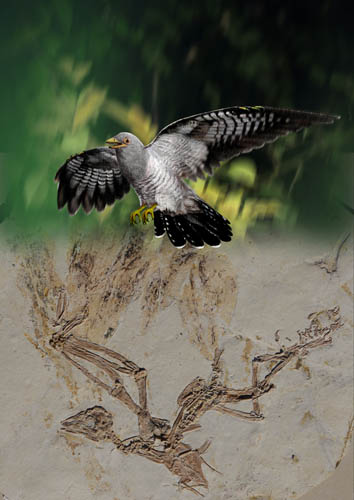A new species of Mesozoic bird was published on December 31 in Current Biology by a collaboration of scientists from the Institute of Vertebrate Paleontology and Paleoanthropology (IVPP), Chinese Academy of Sciences and the Shandong Tianyu Museum of Nature, providing strong evidence that enantiornithines possessed aerodynamic rectricial fans.
The specimen is part of the collections of the Tianyu Museum and comes from the Jehol deposits in Liaoning Province. The new species is a member of the family Pengornithidae, the most basal recognized lineage of enantiornithines. The shape of the beak of the new species differs from that of other pengornithids suggesting that its diet differed from other known species.
The new species, Chiappeavis magnapremaxillo, is named after Dr. Luis Chiappe, Ph D advisor of the lead author, Professor Jingmai O’Connor of the IVPP. Dr. Chiappe is an Argentine paleontologist most famous for discovering the Auca Mahuevo sauropod nesting ground in Patagonia. He is also a major contributor to the study of Mesozoic birds; notably, he was the first to provide cladistic support for the validity of the Enantiornithes making it fitting to name this species of enantiornithine in his honor. Dr. Chiappe is the head of the Dinosaur Institute and Vice President of Research and Collections at the Natural History Museum of Los Angeles County, where Dr. O’Connor was a ‘Graduate Student in Residence’ from 2004 to 2009.
The most interesting aspect of the new specimen is the preserved plumage. Only the flight feathers of the wings and tail are preserved. The tail is formed by approximately ten feathers overlapping to form a cohesive surface capable of generating lift (tail fan). This is the first unequivocal evidence of an aerodynamic tail morphology in the Enantiornithes. All other known specimens, including other closely related pengornithid species, preserve ornamental tail feathers or none at all. A previous study, lead by Dr. Xiaoli Wang of Lingyi University – also an author of the current study, hypothesized that a tail fan represents the primitive condition within Enantiornithes. The discovery of Chiappeavis fulfills this prediction.
The discovery of this new specimen has also led O’Connor and colleagues to suggest for the first time that rectricial bulbs may have been present in enantiornithines, if not a larger group of birds that includes the primitive Sapeornis. The rectricial bulbs are a paired soft tissue structure associated with the pygostyle in living birds that, together with the bulbi rectricium muscle, allows birds to manipulate the shape of their tail in order to maximize aerodynamic function. This structure was previously thought to only exist in the advanced avian lineage, the Ornithuromorpha, which includes all living birds. However, similarities between the pygostyle in pengornithid enantiornithines, ornithuromorphs, and Sapeornis – which also has an aerodynamic tail fan, lead the authors to suggest that all three groups possessed rectricial bulbs or their structural equivalents.
“It is unclear if this feature evolved once or if it had multiple origins,” says Dr. O’Connor, “But if we imagine a single origination, clearly the bulbs would have been very rudimentary in the common ancestor of these groups.” The authors suggest that the bulbs were so poorly developed in basal enantiornithines that this feature was abandoned in most more advanced taxa, thus explaining the dominance of ornamental tail morphologies in this clade.

Fig.1 Reconstruction and specimen of Chiappeavis magnapremaxillo (Image by Jingmai O’Connor)